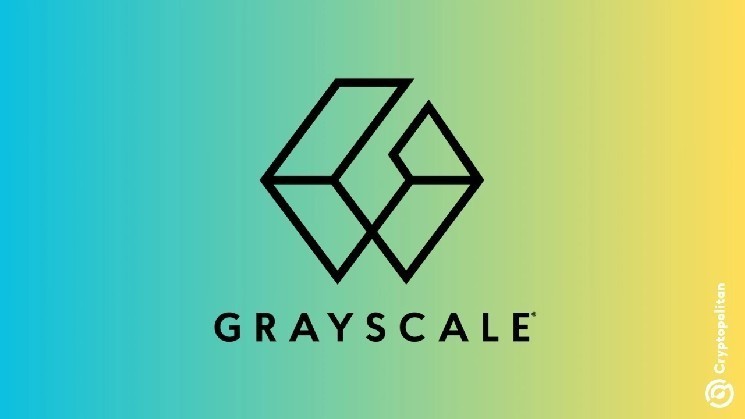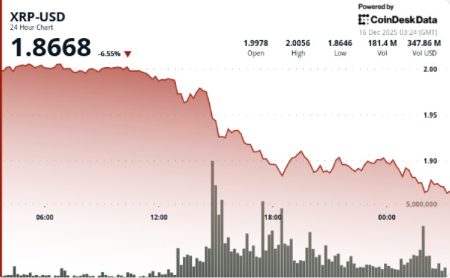Grayscale’s Massive ETH Staking Initiative Creates Unprecedented Bottleneck in Ethereum Network
Ethereum Staking Queue Hits Record Length as Institutional Giant Tests Network Capacity
In what could be described as a real-time stress test of Ethereum’s proof-of-stake infrastructure, investment behemoth Grayscale has triggered the longest validation queue since 2019, exposing significant scalability challenges in the world’s second-largest blockchain network. The company’s ambitious plan to stake 300,000 ETH through its Ethereum Exchange-Traded Product (ETP) has stretched waiting times for new validators to a staggering 23 days, raising questions about the network’s capacity to handle institutional-scale participation.
The bottleneck emerged shortly after Grayscale began implementing its staking strategy, which aims to generate passive yield for investors in its regulated cryptocurrency products. What began as a modest two-day waiting period quickly ballooned as Grayscale ramped up its deposits, contributing a dominant 86% of all recent inflows to Ethereum’s Beacon Chain staking contract. With 51,000 ETH already submitted for validation and hundreds of thousands more potentially on the way, the situation highlights the delicate balance between institutional adoption and network infrastructure limitations.
Network Congestion Raises Concerns for Liquidity and Product Functionality
The expanding queue times don’t just represent a technical curiosity—they pose substantive challenges for the burgeoning cryptocurrency ETF ecosystem. With withdrawal processing now taking up to 41 days, the traditional liquidity expectations associated with exchange-traded products face a fundamental mismatch with blockchain realities. Unlike conventional ETFs that can quickly adjust holdings based on investor demand, staking-enabled cryptocurrency products may struggle to respond to significant redemption requests during periods of market volatility.
“This situation creates a potential liquidity dilemma,” explains a blockchain analyst who requested anonymity. “The entire value proposition of ETFs centers on their ability to efficiently create and redeem shares in response to market conditions. When underlying assets become effectively locked for weeks or even months, that mechanism breaks down.” This structural challenge could become more pronounced if market sentiment shifts rapidly, potentially leaving fund managers unable to free up staked assets quickly enough to meet investor withdrawal demands.
Grayscale’s Initiative Represents Just the Beginning of Institutional Staking Pressure
While Grayscale’s current activities are already stretching network capacity, they represent just the opening act in what promises to be a much larger institutional migration toward staked Ethereum. With regulatory approval for U.S.-based staking ETPs now established and multiple additional products awaiting authorization in coming months, Grayscale alone could potentially stake up to 1.5 million ETH. This volume would represent a substantial percentage of the total staked ETH supply and could further extend already lengthy processing times.
The queue dynamics reflect a fundamental design choice in Ethereum’s proof-of-stake implementation, which prioritizes network security and stability over processing speed. The Beacon Chain deliberately limits the rate at which new validators can join the network, preventing potential attacks while ensuring orderly onboarding. However, this conservative approach was conceived before institutional-scale participation became reality, creating an architectural tension between security requirements and market demands.
Beyond Ethereum: Grayscale Expands Staking Strategy to Include Solana
Not content to limit its staking ambitions to Ethereum alone, Grayscale has simultaneously launched staking operations for its Solana Trust (GSOL), partnering with established validator Figment to manage both initiatives. The expansion demonstrates Grayscale’s comprehensive approach to maximizing yield across its cryptocurrency portfolio, with staking now live across multiple products including the Grayscale Ethereum Trust ETF (ETHE), Grayscale Ethereum Mini Trust ETF (ETH), and the aforementioned Solana offering.
“Selecting the right validation partner represents a critical decision for institutional staking operations,” notes industry expert Sarah Bergstrom. “Figment’s established track record managing over $18 billion in staked assets across 40 different protocols positions them as a natural fit for Grayscale’s expanding staking operations.” The partnership builds on Figment’s existing experience supporting Canadian cryptocurrency ETPs, providing a battle-tested infrastructure for Grayscale’s more ambitious U.S.-based offerings.
Implications for the Future of Institutional Cryptocurrency Adoption
The current staking bottleneck illuminates the growing pains associated with bridging traditional finance and decentralized networks. As cryptocurrency continues its journey from speculative asset to mainstream financial instrument, infrastructure challenges like validation queues highlight the need for scaling solutions that can accommodate institutional-scale participation without compromising network security principles.
For investors in staking-enabled ETPs, understanding these structural limitations becomes increasingly important. The extended lock-up periods and potential liquidity constraints represent meaningful considerations that differentiate cryptocurrency funds from their traditional counterparts. Meanwhile, for Ethereum developers, the Grayscale situation provides valuable real-world data about network capacity under institutional demand—information that will likely influence future protocol upgrades and scaling initiatives.
As the ecosystem continues evolving, finding the right balance between institutional accessibility and network resilience remains a central challenge. Grayscale’s ongoing staking initiative offers a fascinating case study in how these competing priorities interact in practice, potentially reshaping how both traditional finance and blockchain communities approach the next phase of cryptocurrency adoption. Whether Ethereum’s current architecture can efficiently accommodate the wave of institutional staking remains an open question—one whose answer will significantly influence the network’s long-term viability as financial infrastructure.
The Technical Reality Behind Staking Delays
The extended waiting periods for both deposits and withdrawals stem from Ethereum’s careful validator onboarding process. By design, the network admits only a limited number of new validators daily, creating an orderly queue when demand spikes. This approach prevents potential security vulnerabilities that could emerge if large numbers of validators joined simultaneously, but creates operational challenges for institutional participants accustomed to near-instant settlement.
Each validator requires exactly 32 ETH, meaning Grayscale’s planned 300,000 ETH stake would create approximately 9,375 new validators, representing a significant percentage of total network participation. For context, the Ethereum network currently has roughly 872,000 active validators, with Grayscale’s full deployment potentially increasing that number by over 1% from a single entity.
The queue mechanics operate as a safeguard rather than a flaw—a deliberate tradeoff between accessibility and security. However, as institutional adoption accelerates, these constraints highlight the need for layer-2 scaling solutions or protocol adjustments that can better accommodate large-scale participation without compromising Ethereum’s fundamental security model.
For retail investors in staking-enabled ETPs, these technical realities translate to product limitations that must be clearly communicated. The mismatch between traditional ETF liquidity expectations and blockchain staking constraints creates potential friction points during periods of market stress, when rapid redemptions might be impossible to fulfill due to withdrawal queues.
As both regulators and investors gain sophistication in understanding these unique characteristics, product structures may evolve to better align expectations with technological realities. In the meantime, Grayscale’s staking initiative serves as an important real-world experiment, revealing how blockchain networks respond when traditional finance brings institutional-scale capital to decentralized protocols.














